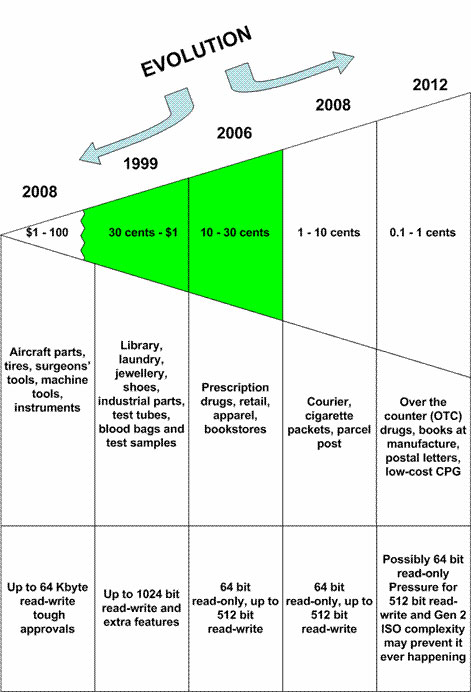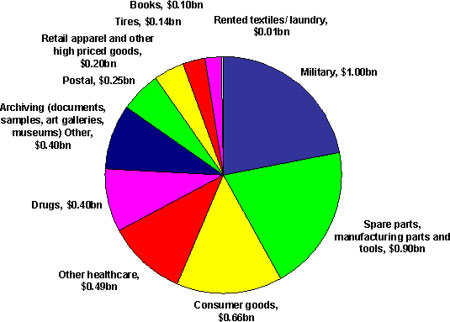| Information technology | ||||||||||||||||||||||||||||||||||||||||||||||||||||||||||||||||||||||||||||||||||||||||||||||
Item-level RFID tagging set for 100-fold growth in decade28 August 2006 Item level RFID is set for substantial growth over the next decade. A new study from IDTechEx forecasts and explores key markets that will apply item-level tagging, advances in technology and the mass adoption that will follow. Dr Peter Harrop from IDTechEx summarises the study. Item-level RFID is the tagging of the smallest taggable unit of a pproduct, eg blood bags, prescription drugs, library books, apparel, jewellery, engineering parts and laundry. Already profitable for most suppliers, item-level tags and systems will be the world's largest RFID market by value from 2007 onwards. The market for item-level RFID tagging is forecast to rocket from $0.16 billion in 2006 to $13 billion in 2016 for systems including tags. In 2006, 0.2 billion items will be RFID tagged worldwide. In 2016, 550 billion items may be RFID tagged. Those adopting item-level tagging today do so willingly and are prepared to pay for good performance as they enjoy rapid multiple paybacks. Relatively problem free This is in some contrast to pallet and case tagging where consumer goods companies are required by retailers to fit the tags regardless of economics. The consumer goods companies are therefore reluctant purchasers of RFID and these tag and interrogator prices are in free fall from oversupply. The RFID tag and interrogator suppliers involved typically lose money. Here we are talking about Far Field UHF tags, which work well enough on pallets, cases and air baggage under US radio regulations but are only relatively trouble free elsewhere in applications with very low reader density, shortish range and dry, non-metallic environments. That means retail apparel in the UK and Japan and books in bookshops in the Netherlands, for example. The problems elsewhere are because, as yet, few countries outside the US permit adequate UHF power levels, bandwidth and signalling protocols for RFID. By contrast, HF is the most popular frequency for item-level tagging and, with well over one billion such tags delivered, it encounters few remaining technical problems. So called Near Field UHF is a promising alternative that may give lower costs when proven in high volume applications. Unique requirements The biggest item-level potential involves uniquely coding very high volume products, such as consumer goods, postal items, apparel, books, drugs and manufactured parts. These total 5-10 trillion items a year. Item-level tagging involves most or all of the following features, and this creates technical and business challenges and benefits that are very different from those in other applications of RFID:
The US Food and Drug Administration will make tagging of up to 20 billion prescription drugs a legal requirement in the US, the TREAD Act will create a tyre tagging market in the US and many new high priced retail items will enjoy the excellent paybacks currently found with apparel in the UK, China and Japan. China will rapidly adopt item-level tagging. Globally, healthcare supplies, tools and assets are being urgently fitted with RFID for safety, security and cost control, including theft reduction. Boeing and Airbus are progressing the tagging of aircraft parts and equipment. Over ten million test samples for blood (Europe) and milk (New Zealand), drug research and other uses have been tagged with the potential of billions yearly. However, it is challenging to meet the most sophisticated requirements for item-level tagging and to evolve appropriate technical specifications and approval procedures for, say, mission critical aircraft parts. At the other extreme it is tough to get down to the price that justifies tagging a can of soda in a supermarket or a letter. Item-level tagging has therefore started with the many lucrative intermediate requirements as shown below and it is rapidly widening in scope. Evolution of item-level RFID tags Evolution of item-level RFID by tag price showing earliest date of mass adoption of leading application in each price band is shown below.
Values of applications of RFID tags Projected values of item-level RFID tag sales by application in 2016 is as shown below:
Change in technology The technology will change. Today most item-level tagging uses HF radio bands, with smaller but significant amounts of Far Field UHF and some 2.45GHz and LF (125-135KHz) tags. Within five years Near Field UHF will become popular and in ten years a significant amount of item-level RFID will be done without a silicon chip, sometimes by direct printing. The average price of just under one cent for an item-level tag in 2016 will cover a range from 0.1 cent primitive ink stripes and thin film transistor circuits to $8 tags for aircraft parts to high specification and even more expensive military tags. Some tags for dangerous, expensive or mission-critical items will have batteries and sensors in them and even act as Real Time Locating Systems (RTLS) on assets in hospitals, museums, art galleries etc, not just in supply chains. The table below shows that the larger potential markets for item-level RFID promise a wider range of benefits. They may not be as price sensitive as is popularly believed.
See www.idtechex.com/item for more information on the reports.
|
||||||||||||||||||||||||||||||||||||||||||||||||||||||||||||||||||||||||||||||||||||||||||||||

